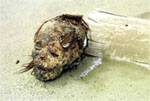 |
4,000-year-old Tombs Re-discovered in Lop Nur

Mysterious Ancient Tombs Re-discovered in Lop Nor
Chinese archaeologists have recently re-discovered the Xiaohe Tombs (Small River tombs) in Lop Nur, a desert in northwest China's Xinjiang Uygur Autonomous Region, after they were first found 66 years ago.
Chinese archaeologists found some 100 wooden poles, which are symbols of the Xiaohe Tombs and demonstrate how people buried the dead, on January 4 , on a sand dune.
The tombs were first found by Folke Bergman, a Swedish archaeologist, in the summer of 1934. The tombs are regarded as the most mysterious place in the exploration of Loulan, an ancient kingdom located in the area, and Xinjiang.
Xiaohe Tombs, covering 2,500 square meters, have remained hidden in the Lop Nur desert from 1934 until the late 1990s when Chinese scientists with the Chinese Academy of Social Sciences (CASS) translated Bergman's book on archaeological exploration in the area into Chinese.

Mysterious Ancient Tombs Re-discovered in Lop Nor
Chinese archaeologists also found bent wooden blocks, human bones, dismembered mummies and woven pieces of wool. But no living plants were found.
Bergman held that mummies unearthed in the area date back 4,000 years and belong to Aryans.
A quant-shaped object found in the area, which was mentioned by Bergman in his book, is one meter long, 70 to 80 cm wide and 10 to 20 cm thick. It is carved out of a poplar tree trunk with a diameter of over one meter, experts said.
Yang Lian, a researcher with the CASS , said that the Xiaohe Tombs might be the imperial tombs of the Loulan Kindom. "They play a very important role in the research of the Loulan civilization and the climatic changes in Lop Nur."
Xiaohe (small river), named by Bergman, runs from south to north in the delta area of the Tarim and Kongque rivers in Xinjiang.
The river was marked as a seasonal river on the geological map of China at the end of the 1950s. The river has since totally dried up.

In This Section

|